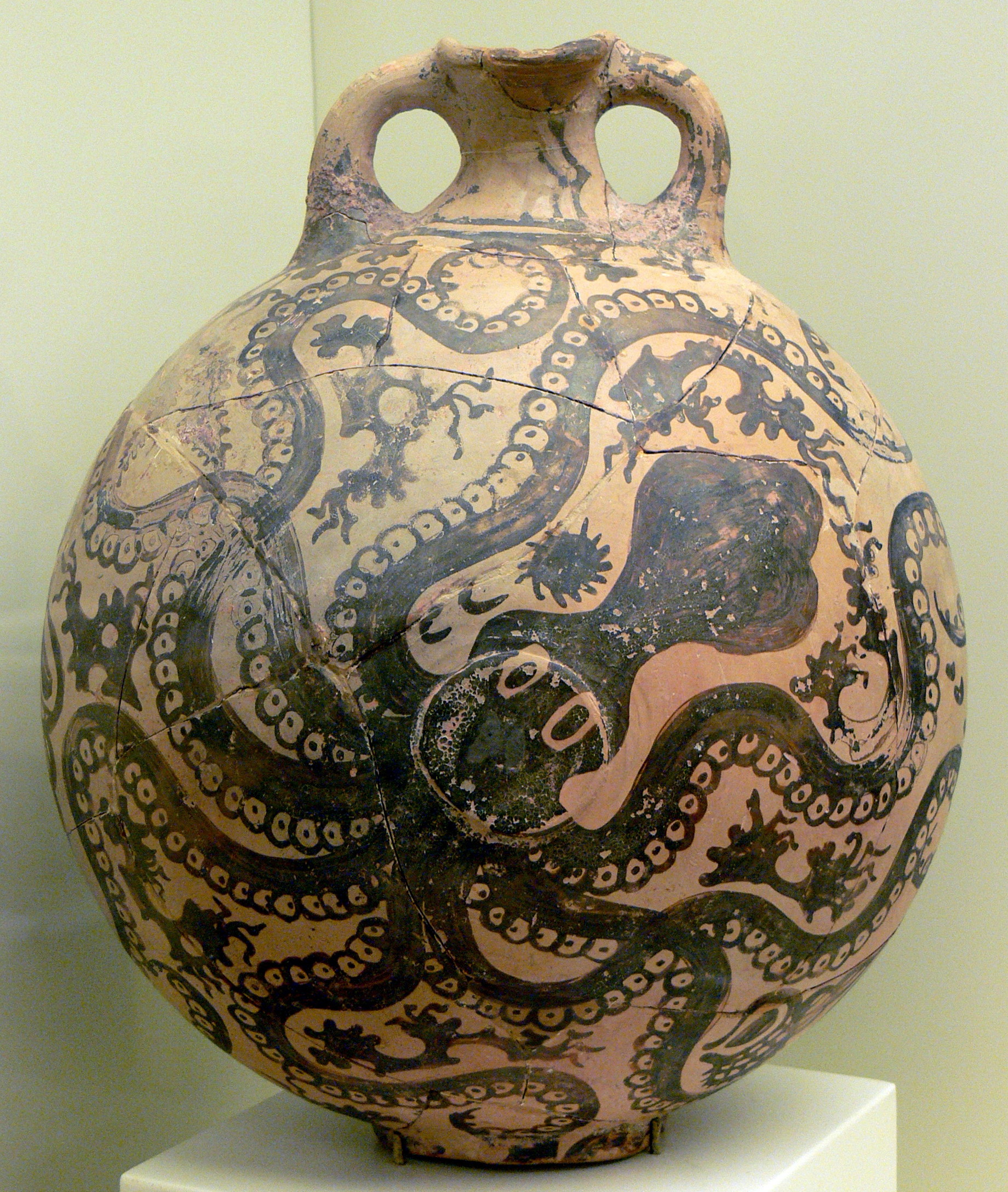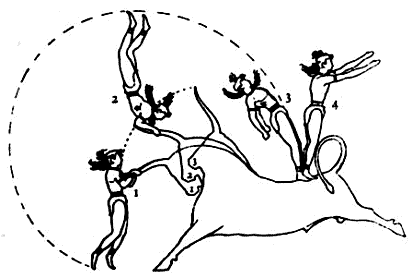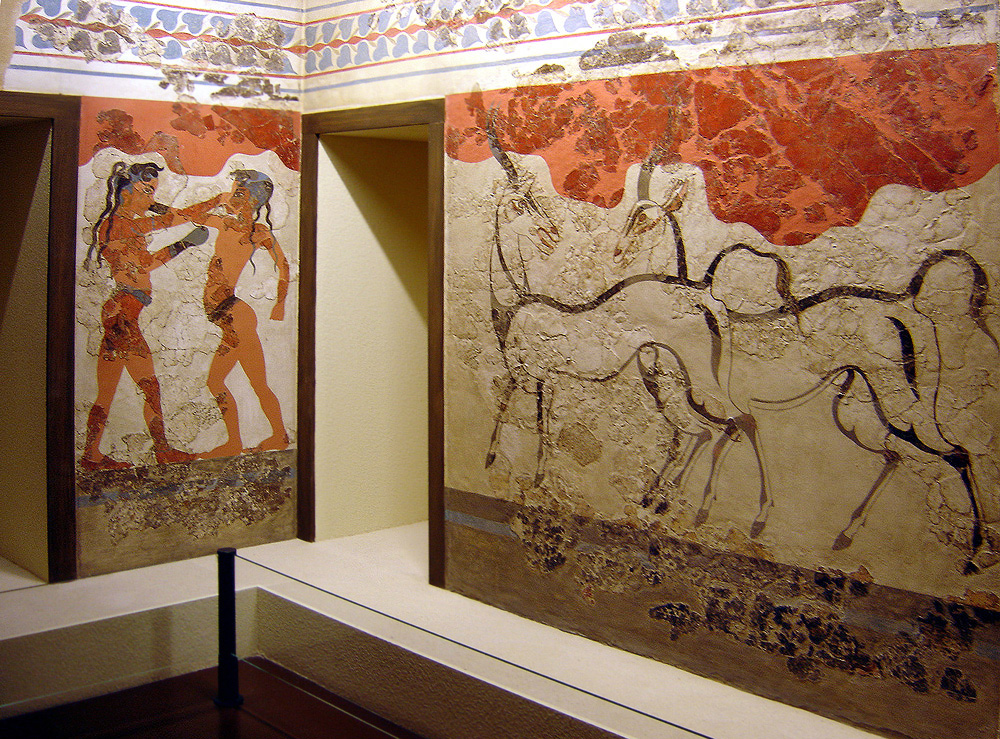|
Akrotiri Boxer Fresco
The Akrotiri Boxer Fresco, discovered in 1967, is one of the Wall Paintings of Thera and a leading example of Minoan painting. It is a fresco depicting two young boys wearing boxing gloves and belts and dates back to the Bronze Age, 1700 BCE. Around 1600 BCE, a disastrous earthquake, followed by a volcanic eruption, covered Akrotiri in a thick layer of pumice and ash, which resulted in the remarkable conservation of frescoes, including the Akrotiri Boxer Fresco, from multiple buildings throughout the town. This particular fresco was found in room B1 of Building Beta along with the Antelope Fresco. The boys' shaved heads and stray locks indicate their youth, while their darker skin tone indicates their gender. The boy on the right is completely nude except for a belt, whereas the boy on the left has jewelry; most likely markers of a higher status. They appear to be slightly over life size at roughly 5'10". In order to create such vibrant frescoes, a smooth lime plaster was applied ... [...More Info...] [...Related Items...] OR: [Wikipedia] [Google] [Baidu] |
Minoan Civilization
The Minoan civilization was a Bronze Age Aegean civilization on the island of Crete and other Aegean Islands, whose earliest beginnings were from 3500BC, with the complex urban civilization beginning around 2000BC, and then declining from 1450BC until it ended around 1100BC, during the early Greek Dark Ages, part of a wider bronze age collapse around the Mediterranean. It represents the first advanced civilization in Europe, leaving behind a number of massive building complexes, Minoan art, sophisticated art, and writing systems. Its economy benefited from a network of trade around much of the Mediterranean. The civilization was rediscovered at the beginning of the 20th century through the work of British archaeologist Sir Arthur Evans. The name "Minoan" derives from the mythical Minos, King Minos and was coined by Evans, who identified the site at Knossos with the labyrinth of the Minotaur. The Minoan civilization has been described as the earliest of its kind in Europe, and his ... [...More Info...] [...Related Items...] OR: [Wikipedia] [Google] [Baidu] |
Buon Fresco
Buon fresco () is a fresco painting technique in which alkaline-resistant pigments, ground in water, are applied to wet plaster. It is distinguished from the fresco-secco (or ''a secco'') and finto fresco techniques, in which paints are applied to dried plaster. Description The buon fresco technique consists of painting with pigment ground in water on a thin layer of wet, fresh, lime mortar or plaster, for which the Italian word is intonaco. Because of the chemical makeup of the plaster, a binder is not required. After a number of hours the plaster reacts with the air in a process called carbonatation. This chemical reaction fixes the pigment particles at the plaster's surface in a protective crystalline mesh known as the lime crust. The advantage of buon fresco is its durability. In ''fresco-secco'', by contrast, the color does not become part of the wall and tends to flake off over time. The chief disadvantage of buon fresco is that it must be done quickly without mistakes. ... [...More Info...] [...Related Items...] OR: [Wikipedia] [Google] [Baidu] |
Spondylolisthesis
Spondylolisthesis is the displacement of one spinal vertebra compared to another. While some medical dictionaries define spondylolisthesis specifically as the forward or anterior displacement of a vertebra over the vertebra inferior to it (or the sacrum), it is often defined in medical textbooks as displacement in any direction.Introduction to chapter 17 in: Page 250 in: Spondylolisthesis is graded based upon the degree of slippage of one vertebral body relative to the subsequent adjacent vertebral body. Spondylolisthesis is classified as one of the six major etiologies: degenerative, traumatic, dysplastic, [...More Info...] [...Related Items...] OR: [Wikipedia] [Google] [Baidu] |
Minoan Pottery
Minoan pottery has been used as a tool for dating the mute Minoan civilization. Its restless sequence of quirky maturing artistic styles reveals something of Minoan patrons' pleasure in novelty while they assist archaeologists in assigning relative dates to the strata of their sites. Pots that contained oils and ointments, exported from 18th century BC Crete, have been found at sites through the Aegean islands and mainland Greece, on Cyprus, along coastal Syria and in Egypt, showing the wide trading contacts of the Minoans. The pottery consists of vessels of various shapes, which as with other types of Ancient Greek pottery may be collectively referred to as "vases", and also "terracottas", small ceramic figurines, models of buildings and some other types. Some pieces, especially the cups of rhyton shape, overlap the two categories, being both vessels for liquids but essentially sculptural objects. Several pottery shapes, especially the rhyton cup, were also produced in soft st ... [...More Info...] [...Related Items...] OR: [Wikipedia] [Google] [Baidu] |
Bull-Leaping Fresco
The bull-leaping fresco is the most completely restored of several stucco panels originally sited on the upper-story portion of the east wall of the palace at Knossos in Crete. It shows a bull-leaping scene. Although they were frescos, they were painted on stucco relief scenes. They were difficult to produce. The artist had to manage not only the altitude of the panel but also the simultaneous molding and painting of fresh stucco. The panels, therefore, do not represent the formative stages of the technique. In Minoan chronology, their polychrome hues – white, pale red, dark red, blue, black – exclude them from the Early Minoan (EM) and early Middle Minoan (MM) Periods. They are, in other words, instances of the "mature art" created no earlier than MM III. The flakes of the destroyed panels fell to the ground from the upper story during the destruction of the palace, probably by earthquake, in Late Minoan (LM) II. By that time the east stairwell, near which they fell, was disu ... [...More Info...] [...Related Items...] OR: [Wikipedia] [Google] [Baidu] |
Minoan Art
Minoan art is the art produced by the Bronze Age Aegean Minoan civilization from about 3000 to 1100 BC, though the most extensive and finest survivals come from approximately 2300 to 1400 BC. It forms part of the wider grouping of Aegean art, and in later periods came for a time to have a dominant influence over Cycladic art. Since wood and textiles have decomposed, the best-preserved (and most instructive) surviving examples of Minoan art are its pottery, palace architecture (with frescos which include "the earliest pure landscapes anywhere"), small sculptures in various materials, jewellery, metal vessels, and intricately-carved seals. It was influenced by the neighbouring cultures of Ancient Egypt and the ancient Near East, which had produced sophisticated urban art for much longer, but the character of the small but wealthy mercantile Minoan cities was very different, with little evidence of large temple-based religion, monarchs, or warfare, and "all the imaginative powe ... [...More Info...] [...Related Items...] OR: [Wikipedia] [Google] [Baidu] |
Tsunami
A tsunami ( ; from ja, 津波, lit=harbour wave, ) is a series of waves in a water body caused by the displacement of a large volume of water, generally in an ocean or a large lake. Earthquakes, volcanic eruptions and other underwater explosions (including detonations, landslides, glacier calvings, meteorite impacts and other disturbances) above or below water all have the potential to generate a tsunami. Unlike normal ocean waves, which are generated by wind, or tides, which are in turn generated by the gravitational pull of the Moon and the Sun, a tsunami is generated by the displacement of water from a large event. Tsunami waves do not resemble normal undersea currents or sea waves because their wavelength is far longer. Rather than appearing as a breaking wave, a tsunami may instead initially resemble a rapidly rising tide. For this reason, it is often referred to as a tidal wave, although this usage is not favoured by the scientific community because it might give ... [...More Info...] [...Related Items...] OR: [Wikipedia] [Google] [Baidu] |
Wall Paintings Of Thera
The wall paintings of ancient Thera are famous frescoes discovered by Spyridon Marinatos at the excavations of Akrotiri (prehistoric city) on the Greek island of Santorini (or Thera). They are regarded as part of Minoan art, although the culture of Thera was somewhat different from that of Crete, and the political relationship between the two islands at the time is unclear. They have the advantage of mostly being excavated in a more complete condition, still on their walls, than Minoan paintings from Knossos and other Cretan sites. Most of the frescos are now in the Prehistoric Museum of Thera on Santorini, or the National Archaeological Museum of Athens, which has several of the most complete and famous scenes. Importance Excavated from 1967 to 1974, the wall paintings provide a crucial window into Santorini's history, depicting the early Aegean world as a highly developed society. Of all the findings unearthed at Akrotiri, these frescoes constitute the most significant co ... [...More Info...] [...Related Items...] OR: [Wikipedia] [Google] [Baidu] |
Santorini
Santorini ( el, Σαντορίνη, ), officially Thira (Greek: Θήρα ) and classical Greek Thera (English pronunciation ), is an island in the southern Aegean Sea, about 200 km (120 mi) southeast from the Greek mainland. It is the largest island of a small circular archipelago, which bears the same name and is the remnant of a caldera. It forms the southernmost member of the Cyclades group of islands, with an area of approximately 73 km2 (28 sq mi) and a 2011 census population of 15,550. The municipality of Santorini includes the inhabited islands of Santorini and Therasia, as well as the uninhabited islands of Nea Kameni, Palaia Kameni, Aspronisi and Christiana. The total land area is 90.623 km2 (34.990 sq mi). Santorini is part of the Thira regional unit. The island was the site of one of the largest volcanic eruptions in recorded history: the Minoan eruption (sometimes called the Thera eruption), which occurred about 3,600 years ... [...More Info...] [...Related Items...] OR: [Wikipedia] [Google] [Baidu] |

.jpg)






